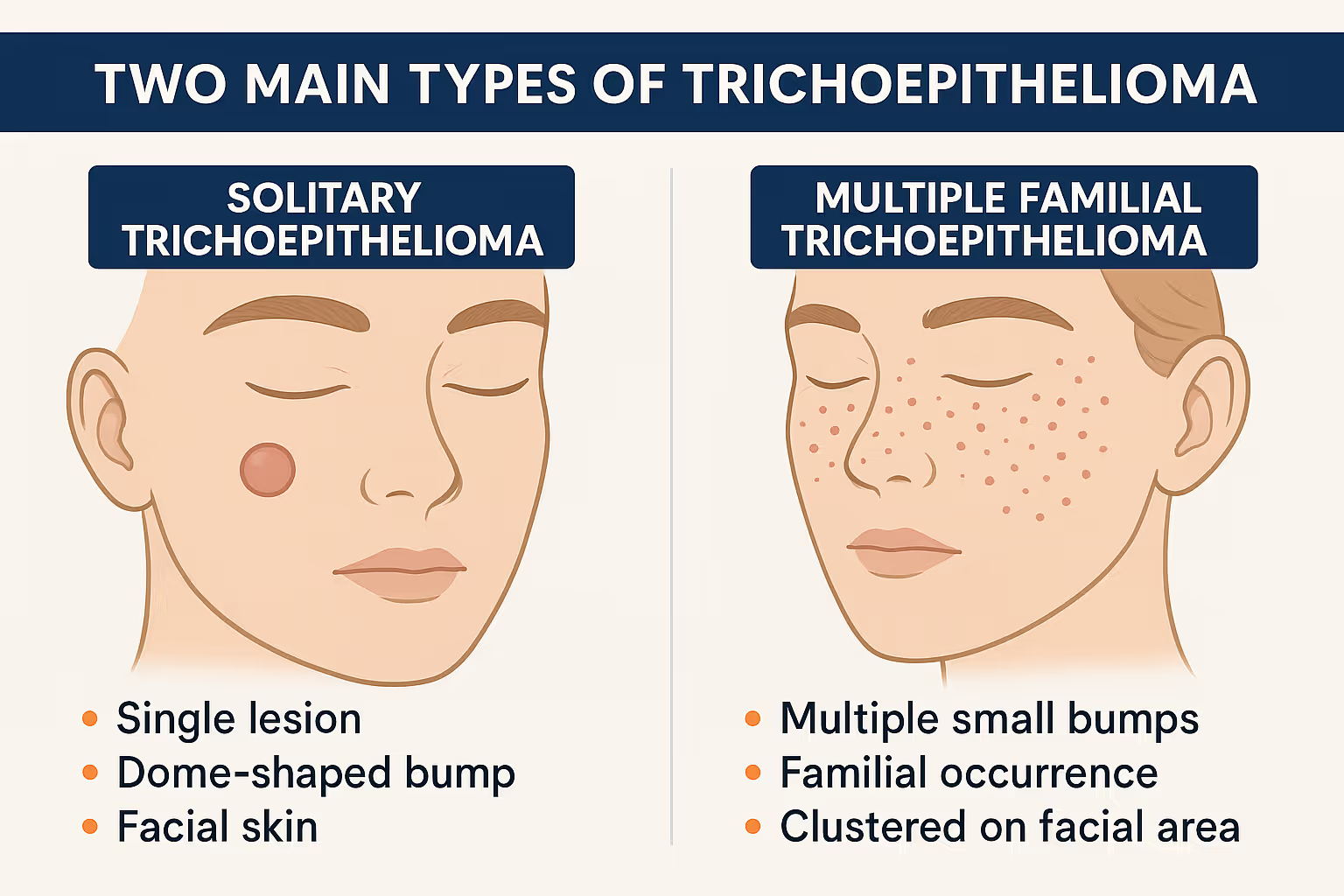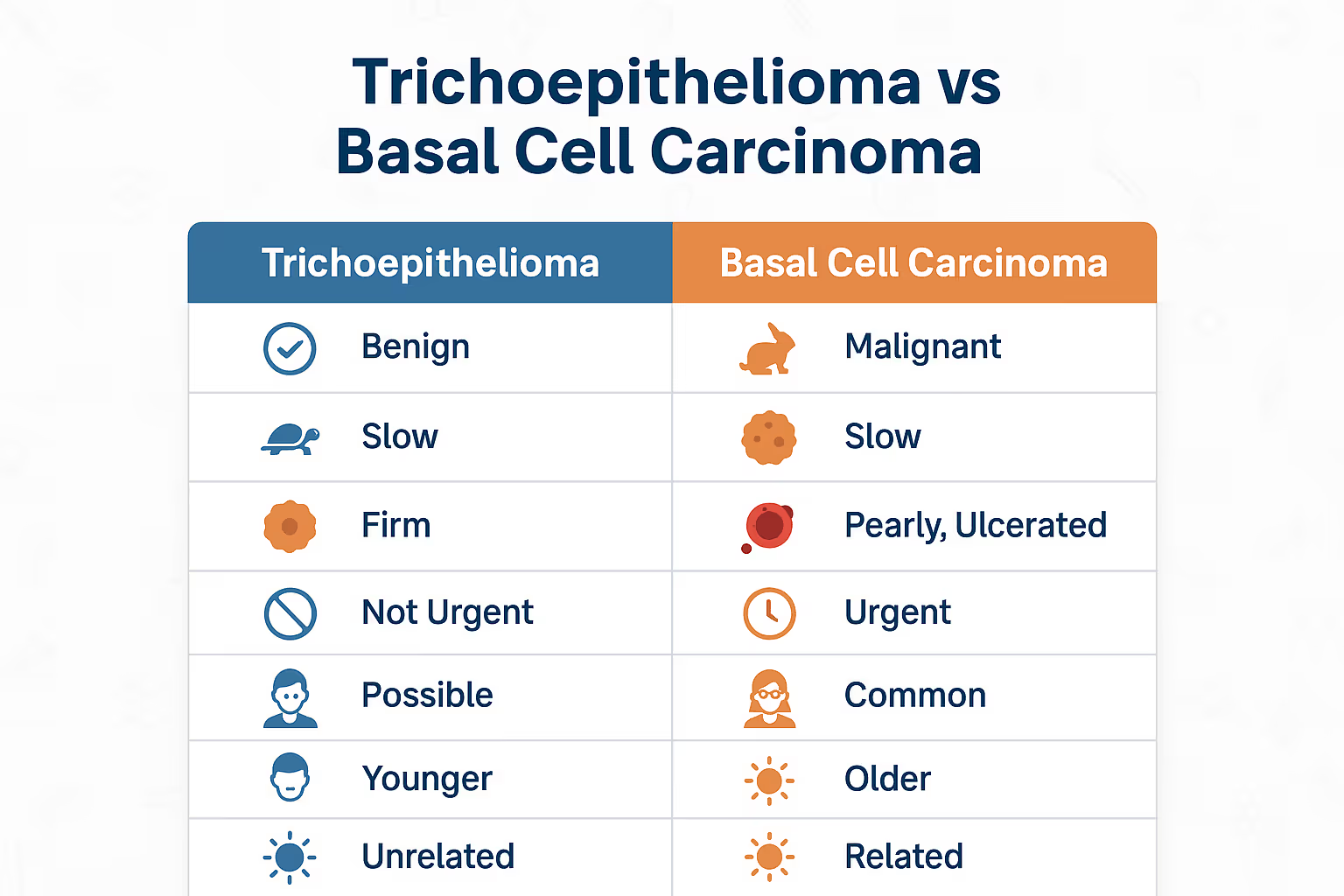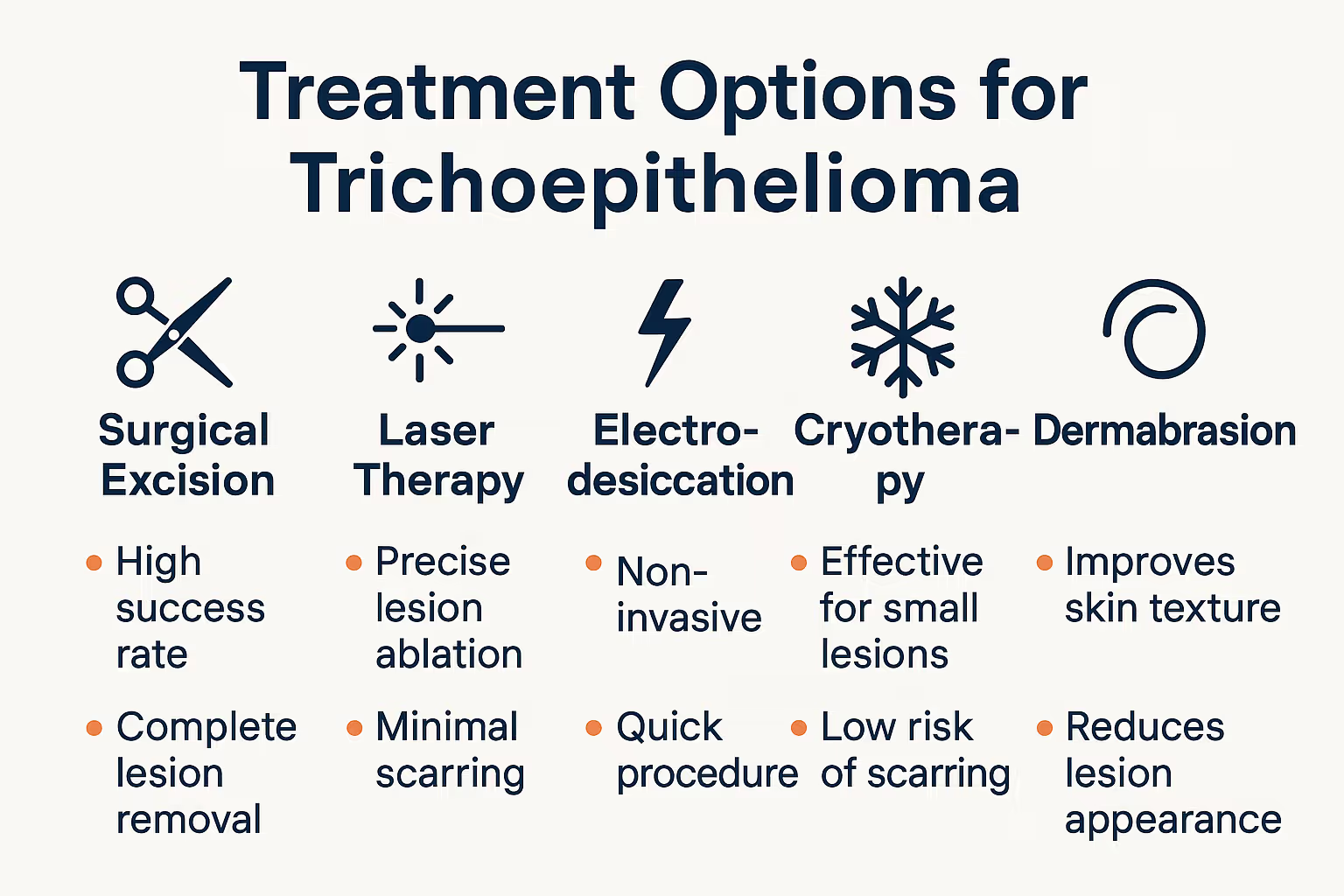When you notice a small, firm bump on your face that won't go away, it's natural to feel concerned. While most skin growths are harmless, understanding what you're dealing with can bring peace of mind—and help you make informed decisions about treatment. If you've been diagnosed with trichoepithelioma or suspect you might have one, you're not alone. This rare but benign skin tumor affects thousands of people, and the good news is that it's completely manageable with the right care.
Trichoepithelioma is a benign skin tumor that develops from hair follicle cells. Though the name might sound intimidating, these growths are non-cancerous and typically appear as small, flesh-colored bumps on the face. Understanding this condition is the first step toward feeling confident in your skin again.
Trichoepithelioma is a benign tumor that develops from the cells of hair follicles. These growths are part of a larger family of skin tumors called follicular tumors, which means they originate from the structures in your skin responsible for hair growth.
Despite their complex medical name, trichoepitheliomas are straightforward to understand. They're non-cancerous growths that don't spread to other parts of the body and rarely cause any symptoms beyond their appearance. However, because they can resemble other skin conditions—some of which require different treatment approaches—proper diagnosis is essential.
Your hair follicles are complex structures embedded in your skin. Each follicle contains multiple types of cells that work together to produce hair. Trichoepitheliomas develop when certain cells within these follicles begin to multiply abnormally, forming small, solid tumors.
The exact reason why this happens isn't fully understood, but research suggests a combination of genetic and environmental factors. In many cases, especially with multiple trichoepitheliomas, there's a clear hereditary component passed down through families.
Understanding which type of trichoepithelioma you have can help guide your treatment decisions and give you insight into what to expect.
Solitary trichoepithelioma appears as a single growth, typically developing during adulthood. This is the most common form you'll encounter in clinical practice.
Characteristics:
Multiple familial trichoepithelioma is an inherited condition where numerous trichoepitheliomas develop over time. This condition follows an autosomal dominant inheritance pattern, meaning if one parent has the gene mutation, each child has a 50% chance of inheriting it.
Characteristics:
Desmoplastic trichoepithelioma is a distinct variant that deserves special mention because it can be particularly challenging to diagnose.
Characteristics:
Recognizing trichoepithelioma can be tricky because these growths often resemble other common skin conditions. Here's what to look for:
Visual Characteristics:
Trichoepitheliomas have a strong preference for certain areas of the body:
LocationFrequencyNotesNoseVery CommonCentral face locationForeheadCommonOften multiple in familial casesUpper LipCommonCan affect both sidesCheeksModerateEspecially nasolabial foldsScalpLess CommonMay be hidden by hairNeckRareOccasionally reportedTrunkVery RareExceptional cases only
Most people with trichoepithelioma experience no physical symptoms beyond the visible growth. Unlike some other skin conditions, these tumors typically don't cause:
The primary concern for most patients is cosmetic—the appearance of the growth, especially when located prominently on the face. This is completely understandable, and it's one of the main reasons people seek treatment at specialized facilities like The Minor Surgery Center.
Heredity plays a significant role in trichoepithelioma development, particularly in the multiple familial form. Researchers have identified mutations in specific genes, including the CYLD gene, which is responsible for regulating cell growth in hair follicles.
If you have multiple familial trichoepithelioma, there's a 50% chance of passing the condition to each of your children. However, solitary trichoepitheliomas don't typically run in families and appear to develop spontaneously.
Unlike some skin conditions that are strongly influenced by sun exposure or lifestyle choices, trichoepithelioma doesn't have clear environmental triggers. However, some factors may play a role:
You may be at higher risk for developing trichoepithelioma if you:

Your journey to diagnosis typically begins with a thorough skin examination by a qualified healthcare professional. At The Minor Surgery Center, experienced surgeons can often identify trichoepithelioma based on its appearance and location.
During the examination, your doctor will assess:
Dermoscopy is a non-invasive technique that uses a special magnifying device to examine skin lesions more closely. This tool helps doctors visualize structures beneath the skin's surface that aren't visible to the naked eye.
Dermoscopic features of trichoepithelioma may include:
While clinical examination and dermoscopy provide valuable information, a skin biopsy is often necessary to confirm the diagnosis. This is particularly important because trichoepithelioma can look very similar to basal cell carcinoma—a common type of skin cancer that requires different treatment.
Types of biopsy:
The tissue sample is then examined under a microscope by a pathologist who can identify the characteristic cellular patterns of trichoepithelioma.
Several other skin conditions can resemble trichoepithelioma, making professional evaluation crucial:
Common conditions that may be confused with trichoepithelioma:
This is why seeking care from experienced professionals who understand these subtle differences is so important. You can explore various skin conditions to better understand what you might be dealing with.
The good news is that trichoepithelioma is highly treatable. Since these growths are benign, treatment is optional and primarily driven by cosmetic concerns or diagnostic certainty. However, many people choose to have them removed to feel more confident in their appearance.
Surgical excision is the most definitive treatment option and involves completely removing the growth along with a small margin of normal tissue.
Advantages:
Considerations:
At The Minor Surgery Center, surgical excision is performed by skilled surgeons who specialize in minimizing scarring while ensuring complete removal. The procedure is typically quick, performed under local anesthesia, and you can return home the same day.
This technique combines scraping (curettage) and burning (electrodesiccation) to remove the growth.
How it works:
Best for:
Laser treatment uses focused light energy to destroy the tumor tissue. Several types of lasers can be effective:
Advantages:
Considerations:
Cryotherapy involves freezing the growth with liquid nitrogen, causing the cells to die and the lesion to fall off.
Advantages:
Limitations:
Dermabrasion mechanically removes the upper layers of skin, including the trichoepithelioma.
Best for:
Since trichoepitheliomas are benign, simply monitoring the growth is a valid option, especially if:
Regular check-ups ensure any changes are detected early.
Selecting the best treatment approach depends on several factors:
Consider these questions:
You can get a better understanding of potential costs by using the minor surgery cost estimator tool.
Whether you're having surgical excision, laser treatment, or another procedure, here's what typically happens:
Before the procedure:
During the procedure:
After the procedure:
Recovery varies depending on the treatment method:
Surgical excision:
Laser or cryotherapy:
Electrodesiccation:
One of the biggest concerns people have is scarring. The good news is that with modern techniques and experienced surgeons, scarring can be minimal and often fades significantly over time.
Factors affecting scarring:
The expert team at The Minor Surgery Center specializes in techniques that prioritize excellent cosmetic results.
If you have multiple familial trichoepithelioma, managing the condition requires a thoughtful, long-term approach.
Regular monitoring:
Treatment planning:
Emotional support:
If you have multiple familial trichoepithelioma, genetic counseling can provide valuable information about:
While you can't prevent trichoepithelioma, especially if it's genetic, you can take steps to detect new growths early:
✅ Perform regular self-examinations
✅ Take photos to track changes
✅ Schedule annual professional skin checks
✅ Protect your skin from sun damage
✅ Maintain overall skin health

This is perhaps the most critical distinction to understand. While trichoepithelioma is benign, basal cell carcinoma (BCC) is a form of skin cancer. The two can look remarkably similar, which is why professional evaluation is essential.
FeatureTrichoepitheliomaBasal Cell CarcinomaNatureBenignMalignant (cancerous)Growth rateSlow, stableProgressiveUlcerationRareCommon in advanced casesBleedingRareMay bleed easilyMultiple lesionsPossible (familial type)Usually solitaryAge of onsetOften youngerUsually older adultsTreatment urgencyElectiveShould be treated
Getting the right diagnosis is crucial because:
This is why seeking care from experienced professionals who can properly diagnose and treat your condition is so important. The team at The Minor Surgery Center has extensive experience distinguishing between these conditions.
No, trichoepithelioma is a benign (non-cancerous) growth that doesn't spread to other parts of the body. However, it's important to have any new skin growth evaluated by a professional to ensure accurate diagnosis.
Trichoepitheliomas do not transform into cancer. They remain benign throughout their existence. However, because they can resemble basal cell carcinoma, proper diagnosis is essential to rule out malignancy.
Unfortunately, trichoepitheliomas do not spontaneously resolve. Once formed, they typically persist indefinitely unless treated. They may remain stable in size or grow very slowly over time.
Treatment is not medically necessary since these growths are benign. However, many people choose treatment for:
Costs vary depending on the treatment method, number of lesions, and your location. Factors include:
For a personalized estimate, check out the cost estimator tool.
Insurance coverage varies. Medical necessity often determines coverage:
Recurrence is rare after complete surgical excision. However:
Since trichoepithelioma is primarily genetic, there's no proven prevention method. However, you can:
You should schedule an appointment with a healthcare professional if you:
🔴 Notice a new growth on your face or body
🔴 Have a bump that's changing in size, color, or texture
🔴 Experience bleeding, pain, or other symptoms
🔴 Have multiple similar growths developing
🔴 Have a family history of skin conditions
🔴 Want cosmetic removal of an existing growth
🔴 Need confirmation of a previous diagnosis
Don't wait or worry in silence. Professional evaluation brings clarity and peace of mind. You can explore the various FAQs to learn more about what to expect during your visit.
When it comes to diagnosing and treating trichoepithelioma, experience matters. Specialized centers that focus on minor surgical procedures offer distinct advantages:
Professionals who regularly see and treat trichoepitheliomas can:
Surgeons who specialize in facial and cosmetic procedures bring:
Specialized centers focus on:
From initial consultation through recovery, you receive:
At The Minor Surgery Center, you'll find a team dedicated to making your experience as comfortable and successful as possible.
While trichoepitheliomas are medically benign, their emotional impact can be significant, especially when they appear on visible areas of the face.
It's completely normal to feel:
These feelings are valid, and they're an important part of why many people choose treatment.
Remember that you have options:
"Feeling confident in your skin isn't vanity—it's an important part of your overall well-being. That's why we're here to help." – The Minor Surgery Center team

Medical science continues to advance our understanding of trichoepithelioma and develop new treatment options.
Scientists are investigating:
While still in various stages of development, promising areas include:
If you have trichoepithelioma, especially the familial type, staying informed about new developments can be helpful. Reliable sources include:
You can also check the blog at The Minor Surgery Center for updates on skin conditions and treatments.
While we can't share specific patient stories without permission, common themes emerge from people who've been diagnosed with and treated for trichoepithelioma:
Many people describe:
Common experiences include:
Most people report:
If you've been diagnosed with trichoepithelioma or suspect you might have one, you're now equipped with comprehensive information to make an informed decision about your care.
Personal considerations:
Medical considerations:
When you consult with a surgeon or dermatologist:
You deserve to feel confident in your skin. Whether you're dealing with a single trichoepithelioma or multiple growths, expert care is available to help you achieve your goals.
Step 1: Get a Professional Evaluation
Schedule a consultation with an experienced healthcare provider who can accurately diagnose your condition.
Step 2: Confirm the Diagnosis
If recommended, undergo a biopsy to ensure accurate identification and rule out other conditions.
Step 3: Explore Your Options
Discuss all available treatment approaches and their pros and cons specific to your situation.
Step 4: Make an Informed Decision
Choose the treatment that aligns with your goals, timeline, and budget.
Step 5: Schedule Your Procedure
Work with your healthcare provider to plan your treatment at a convenient time.
Step 6: Follow Aftercare Instructions
Ensure optimal healing and cosmetic results by carefully following post-procedure guidance.
Step 7: Monitor and Maintain
Continue regular skin checks and address any new concerns promptly.
Trichoepithelioma, while rare, is a well-understood and highly treatable benign skin condition. Whether you have a single growth or multiple familial trichoepitheliomas, you now have the knowledge to understand your condition and make informed decisions about your care.
Remember these key points:
✅ Trichoepithelioma is benign—it's not cancer and won't spread
✅ Professional diagnosis is essential—accurate identification guides appropriate treatment
✅ Multiple effective treatments exist—from surgical excision to laser therapy
✅ Cosmetic outcomes are generally excellent—especially with experienced surgeons
✅ You have control—treatment is your choice based on your goals and preferences
The most important step is seeking professional evaluation from experienced providers who understand these growths and can offer expert care. At The Minor Surgery Center, you'll find a team dedicated to providing safe, effective, and compassionate treatment in a welcoming environment—without the long wait times or confusion that can accompany medical care.
You deserve expert care that's simple, accessible, and focused on your needs. Whether you need a diagnosis, want to discuss treatment options, or are ready to schedule removal, experienced professionals are here to help you feel confident in your skin again.
Don't let uncertainty or concern hold you back. Take the first step toward clarity and confidence by scheduling a consultation today. Your skin is your specialty—and helping you care for it is ours.